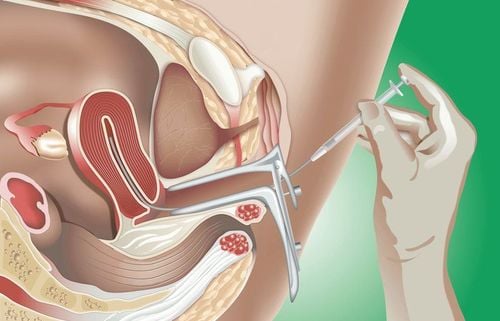This is an automatically translated article.
The article was professionally consulted with Specialist Doctor Obstetrician and Gynecologist - Department of Obstetrics and Gynecology - Vinmec Hai Phong International General Hospital.
Umbilical cord prolapse is a common condition in cases of very high fetal position that does not fall into the pelvis, preterm pregnancy, abnormal fetal position, polyhydramnios, unqualified amniotic fluid, sudden rupture of membranes... Truong The case of umbilical cord prolapse when the water has broken is especially dangerous and requires definitive and urgent handling to promptly protect the life of the fetus.
1. Overview
The umbilical cord plays an important role in carrying nutrients and oxygen to the fetus in the womb. If the umbilical cord is compressed, compressed for a long time will affect this blood and oxygen transmission process, affecting the baby's heart rate and development. Umbilical cord prolapse is a condition in which the umbilical cord prolapses, below the fetal throne.
There are 2 cases of fetus having umbilical cord prolapse in amniotic sac and umbilical cord prolapse after amniotic fluid rupture. The second case is dangerous because after the prolapse, the circulation through the umbilical cord will be stopped, the umbilical cord will lose water and dry up, making the baby fall into a critical condition. If the cesarean section is not performed early, the fetus will die within 30 minutes. It is estimated that for every 300 babies born, there will be 1 case of fetal umbilical cord prolapse.
During labor and waiting for delivery, the umbilical cord is likely to be stretched and compressed, leading to fetal umbilical cord prolapse. In addition, during pregnancy, the baby's hyperactivity, premature rupture of membranes can also be other causes of umbilical cord prolapse.
Premature rupture of membranes is when the amniotic membrane surrounding the fetus breaks before labor. If the water breaks before 32 weeks of pregnancy, there is a 32-76% chance of a prolapsed umbilical cord. The fact that the umbilical cord is moved down the vagina before labor is also a cause of the umbilical cord being compressed.

2. Prolapsed umbilical cord when amniotic fluid has broken is dangerous?
Umbilical cord prolapse is usually discovered soon after the water breaks, but can occur in many other situations as well. Any cause can create a force strong enough to sweep the umbilical cord down or create a gap wide enough for the umbilical cord to prolapse in front of the fetal position.
When the fetal heart rate changes due to compression of the umbilical cord, it may lead to complications of fetal distress such as: a sudden decrease in heart rate, a drop in blood pressure, and a decrease in oxygen levels. The umbilical cord is compressed so that the veins on the umbilical cord are also compressed, causing the accumulation of CO2 in the blood, leading to respiratory acidosis.
The damage suffered by a prolapsed fetus depends on how long the umbilical cord is compressed. If the umbilical cord is compressed for a long time, the amount of blood and oxygen transmitted to the fetal brain will decrease, causing brain damage or even death.
3. Handling prolapsed umbilical cord when water has broken
In the case of small cord prolapse, the pregnant woman can be treated by increasing the amount of oxygen to increase the amount of blood transferred through the umbilical cord to the fetus, or by infusion of amniotic fluid (saline solution at room temperature) into the mother's uterus at the time of delivery. labor to relieve pressure on the umbilical cord.

And if there are signs of serious fetal umbilical cord prolapse such as fetal distress, the person performing the emergency work needs to quickly answer two questions:
How is the baby's survival status? To determine the fetal status, you can listen to the fetal heart or read the EFM recording (obstetric monitor), evaluate the umbilical cord is still beating or not.
If the fetus is still alive, what are the conditions for an emergency delivery? If it is possible to save the situation, it is necessary to find a way to get the baby out as soon as possible, possibly taking into account the case of a non-delayed cesarean section in the condition of emergency C-section to save the baby's life and protect the baby. mother's health.
While waiting for emergency surgery, by all means reduce the bad effects of umbilical cord compression by:
Pregnant women keep the prone position with hips raised, or raise the buttocks high to reduce pressure on the umbilical cord. Continuous fetal heart rate monitoring prior to surgery. Insert your hand into the vagina to push the fetal position up to reduce pressure on the umbilical cord. Umbilical cord prolapse is an obstetric condition that can cause dangerous complications, even killing the fetus, so pregnant women need regular antenatal checkups, especially from week 38 onwards. For high-risk cases, women should stay in the hospital to be monitored and cared for until safe childbirth. In the last 3 months of pregnancy, the health of both mother and baby needs to be closely monitored and checked. Pregnant women need:
Know the real signs of labor to get to the hospital in time, affecting the health of the fetus.

Differentiate between amniotic fluid and vaginal discharge for timely handling to avoid premature birth, fetal distress, and stillbirth. Be especially careful when bleeding in the last 3 months of pregnancy needs urgent emergency care to ensure the life of both mother and baby. Monitor the amount of amniotic fluid regularly and continuously. Monitor fetal weight in the last 3 months to assess baby's development and predict possible risks at birth. The special monitoring group is the same as the striker, and the fetal growth retardation needs to be closely monitored by the doctor and given appropriate indications. Distinguish between physiological contractions, labor contractions and mechanical pregnancy to get to the hospital in time. Maternity services at Vinmec make the pregnancy process easier and safer for pregnant women. During pregnancy, pregnant women will be examined by top doctors in the Obstetrics and Gynecology Department with high professional qualifications and experience, giving the best advice and treatment for the health of both mother and child. little.
For detailed information about all-inclusive maternity service packages, please contact the hospitals and clinics of Vinmec Health system nationwide.
Please dial HOTLINE for more information or register for an appointment HERE. Download MyVinmec app to make appointments faster and to manage your bookings easily.













